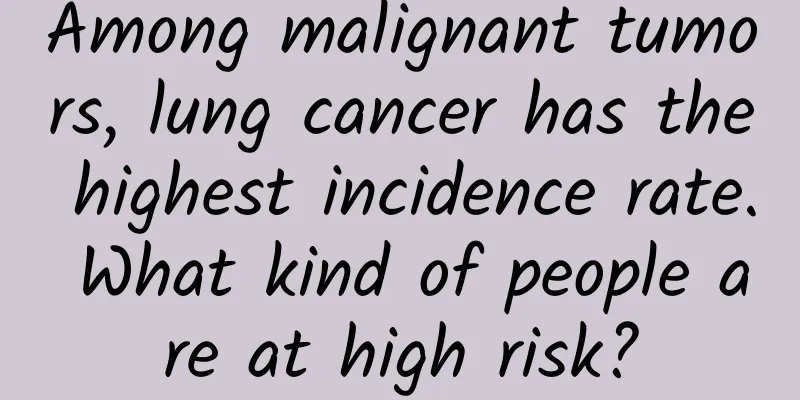Among malignant tumors, lung cancer has the highest incidence rate. What kind of people are at high risk?

|
A friend found a 4mm lung nodule during a CT scan, but he had no symptoms. The doctor suggested that he continue to observe, but he was worried and asked Huazi what he should do. Huazi said that he could follow the doctor's advice and not treat it for the time being. He just needed to continue to observe. It would not be too late to treat it if abnormalities were found. Because a 4mm lung nodule is not very dangerous. However, regular check-ups are necessary because lung cancer is the most common malignant tumor in the world and also the most common cancer in my country, so we must pay attention to prevention. 1. Most lung cancers are diagnosed at an advanced stage Lung cancer ranks first in the world in the incidence of malignant tumors. Someone once asked Huazi why many people are diagnosed with lung cancer in the late stage? Huazi said that this is because most lung cancer patients will go to the hospital for examination only when they have symptoms such as coughing, coughing up blood or chest pain, and these symptoms often appear in the middle and late stages of lung cancer. If lung cancer can be detected early, the cure rate through surgery can reach 80%~90%, but in the late stage of lung cancer, the chance of surgery may be lost, the treatment effect will be greatly reduced, and the 5-year survival rate is only about 20%. Therefore, to prevent lung cancer, high-risk groups must pay attention to early screening. 2. Characteristics of people at high risk of lung cancer People at high risk of lung cancer are those over 40 years old who have one or more of the following risk factors. Risk factors include: 1. Heavy smoking: The number of cigarettes smoked per day multiplied by the number of years of smoking will give a smoking index. If this value is greater than 400, it is considered heavy smoking. For example, if you smoke 30 cigarettes a day and have been smoking for 15 years, then the smoking index is 450. People with a smoking index greater than 400 are still considered to be at high risk of lung cancer even if they quit smoking but have not quit for 15 years. 2. History of exposure to hazardous compounds: long-term exposure to toxic substances such as asbestos, beryllium, uranium, radon, etc. at work or in the environment. 3. History of lung disease: previous history of tuberculosis, diffuse pulmonary fibrosis, or chronic obstructive pulmonary disease (COPD), etc. 4. Tumor-related diseases: already suffering from malignant tumors in other parts of the body, or a direct relative with a history of lung cancer. 5. Passive smoking or fumes: close contact with smokers, passive inhalation of secondhand smoke for more than 20 years; long-term cooking in poorly ventilated places, exposure to kitchen fumes, or using rural stoves for more than 20 years. 3. What should be paid attention to in early screening of lung cancer? The commonly used method for screening lung cancer internationally is to perform low-dose spiral CT scans, which only require one-seventh of the radiation dose of normal CT scans to obtain clear lung images. Early lung cancer manifests as lung nodules, and CT scans have a high accuracy rate. However, most lung nodules are not lung cancer, especially non-solid nodules that are smaller than 8 mm and have no blood vessels passing through them, which are safer. Therefore, after the lung nodules are found, if the danger is not great, you can temporarily not treat them. Check every 6 months to 1 year to observe the lung nodules. If there are any changes, then treat them. It should be noted that the method of testing lung cancer-related tumor markers through blood draws is not very sensitive and is not suitable for early screening of lung cancer. It can only be used as an auxiliary examination method. If lung cancer-related tumor markers are found to be excessive or progressively elevated, it is necessary to combine CT and other imaging methods for diagnosis. Removing diseased tissue samples for pathological examination is the gold standard for lung cancer diagnosis. However, taking tissue samples for puncture is traumatic to the body and may cause complications such as pneumothorax, hemothorax, and even cancer metastasis. Therefore, if typical lung cancer features are present in imaging examinations, direct surgery can be chosen to remove samples for pathological examination during the operation. Surgery, radiotherapy, chemotherapy, and targeted drugs are all effective weapons for treating lung cancer, but the key to treatment is early detection. People at high risk of lung cancer should pay attention to early screening. A low-dose spiral CT scan during an annual physical examination can be a good way to screen for lung cancer. I am pharmacist Huazi, welcome to follow me and share more health knowledge. |
<<: When elderly people have vision problems, don’t say it’s presbyopia
>>: The more you chew betel nut, the more delicious it tastes, but oral cancer is getting closer
Recommend
A bloated belly means your period is not coming
What should I do if my belly is bloated and it me...
Can I drink lemon tea during menstruation?
Menstruation is a special period for every woman,...
How to make the dry skewers in the barbecue restaurant? How to use the barbecue paper?
During the grilling process, the protein will und...
What to do if you get "hot" after eating oranges, eating melon seeds, and drinking beverages during the Chinese New Year? 4 ways to relieve it
During the holidays at home, I can’t stop eating ...
What should women do if urination causes stinging?
In our daily life, many women experience pain whe...
What will happen if you blow dry the hair after painless abortion?
After having an abortion, whether it is a painles...
Can I take a bath during my menstrual period?
Can I take a bath during my period in the dog day...
Don’t be afraid of “long nights and many dreams”! Let’s take a look at some knowledge about dreams
Living together with your dream partner, becoming...
Sperm and egg to produce a boy or a girl
Many people are quite concerned about having a bo...
Causes of left lower quadrant pain
IUD is a very good contraceptive measure. In our ...
What to do if you gain weight during menstruation
Many female friends will have the same feeling. W...
What are the health methods for women to delay aging?
Delaying aging and maintaining youthfulness shoul...
Why do breasts sometimes hurt and sometimes not?
Breasts are one of the most important symbols of ...









